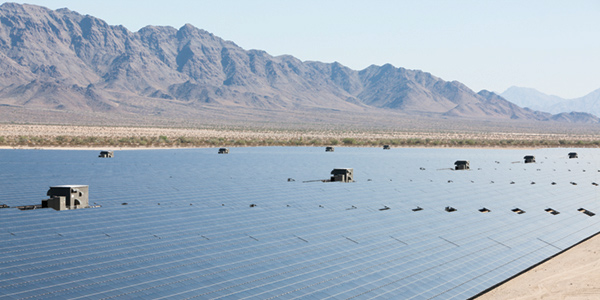By Robert Mullin
Solar photovoltaic resources can provide ancillary services in a way comparable to — or better than — conventional generating resources, according to a study released by CAISO last week.
That finding was based on testing conducted last August in collaboration with the National Renewable Energy Laboratory (NREL), First Solar and Southern Co. using a 300-MW solar facility within the CAISO footprint.
“These test results demonstrated how smart inverter technology can leverage PV technology from simply generating as a variable energy resource to providing ancillary services, such as spinning reserves, load following, voltage support, ramping, frequency response and regulation, and power quality,” the ISO said.
The tests were performed to address industry concerns about transmission reliability as a growing amount of renewable resources interconnect with the grid — the result of both state renewable energy mandates and the increasing cost-competitiveness of wind and solar generation.
Unlike conventional generators that have the ability to automatically vary their turbines’ rotational speed and output based on the pull of load, nonconventional technologies typically have little or no inertial response to momentary changes on the grid.
That built-in capability of conventional resources functions as a kind of damper for frequency excursions. It also leaves those resources better equipped than renewable generation to offer key grid services such as frequency response and voltage support.
The CAISO findings could undermine that conventional wisdom and expand market options for renewable resources, as the ISO develops and refines market mechanisms intended to compensate resources equipped to rapidly react to automatic signals to respond to grid disturbances — both of which are increasingly likely to occur because of increased penetration by variable renewable resources. (See CAISO Seeks Primary Frequency Response Market.)
The results also demonstrate that renewables can, within certain limits, provide the fast-ramping capability needed to respond to variable output from renewable generation located in other areas of the grid — in effect using renewables to integrate renewables.
“These findings mean renewable energy in the ISO footprint — and beyond — could be integrated into power grids at a much higher level and faster pace than once believed, giving a glimpse at the future green and sustainable electric networks,” Clyde Loutan, the ISO’s senior advisor for renewable energy integration, said in a statement. “With these results, the electric industry can expect one day to realize ambitious goals of using primarily renewable sources to power our economy.”
The report notes that a key aspect of the “grid-friendly” nature of First Solar’s solar power plant is a plant-level controller, or PPC, developed by the company to regulate the plant’s real and reactive power output and ensure that the PV arrays collectively function as a single generator.
“Although the plant is comprised of individual inverters, with each inverter performing its own energy production based on local solar array conditions, the function of the plant controller is to coordinate the power output to provide typical large power plant features, such as [advanced process control] and voltage regulation through reactive power regulation,” the report said.
As a result, the PPC, and the facility as a whole, are capable of providing such functions as output curtailment in order to avoid an operator-specified limit, ramp-rate control to ensure that the plant ramps up or down as directed, and frequency response service.
Improvements in inverter technology can allow a solar plant to provide “essential reliability services” and enable renewable resources to help further integrate additional renewable resources, the ISO said.
“These tests demonstrated how controls can leverage the value of solar photovoltaic plants from being simply a variable energy resource to providing services that range from spinning reserves, load following, voltage support, ramping, frequency response and regulation, to power quality,” said Vahan Gevorgian, chief engineer at NREL’s Power Systems Engineering Center.
The ISO plans to perform similar testing on a large wind farm, which it expects will also be positioned to provide reliability services based on the use of similar technology.
The use of solar and wind resources to provide such services will enable the ISO to move more emissions-free power into its system during periods of high renewable production, an “essential” development for California to meet its statutory mandate of generating half of its electricity from renewables by 2030, according to the ISO.
“The next steps are to identify regulatory and operational barriers to the feasibility of renewables providing essential reliability services and explore economic and contractual incentives to maximize the potential for renewables to provide these services,” the ISO said.





